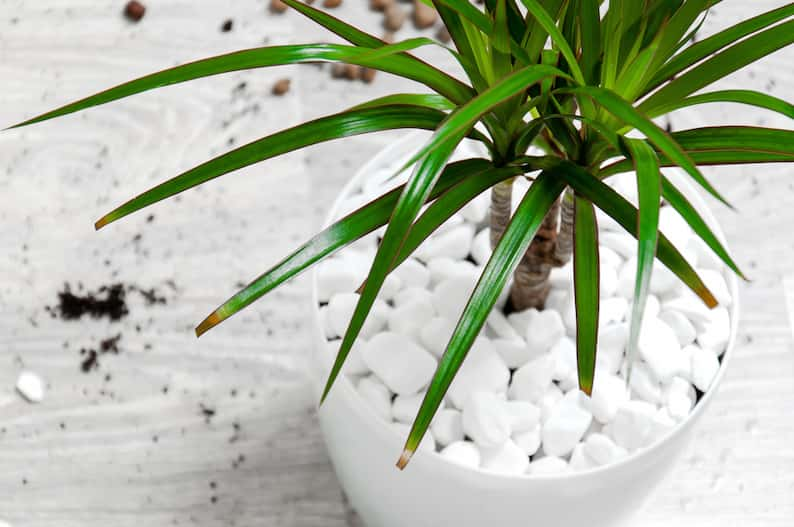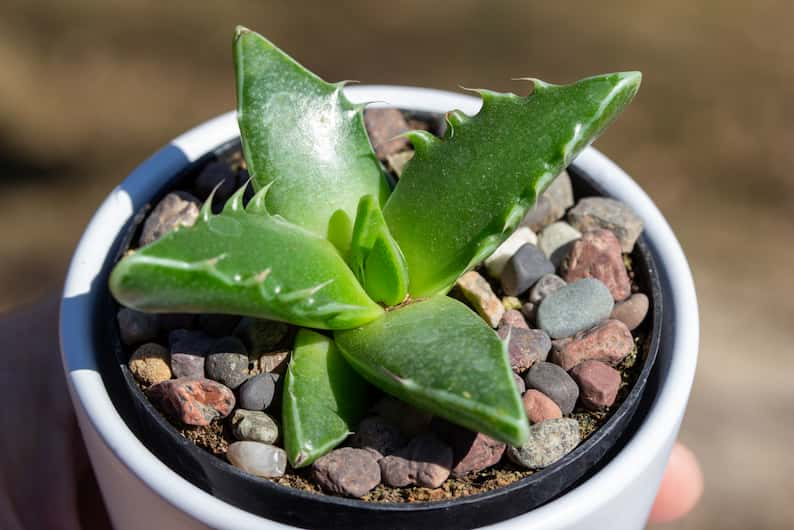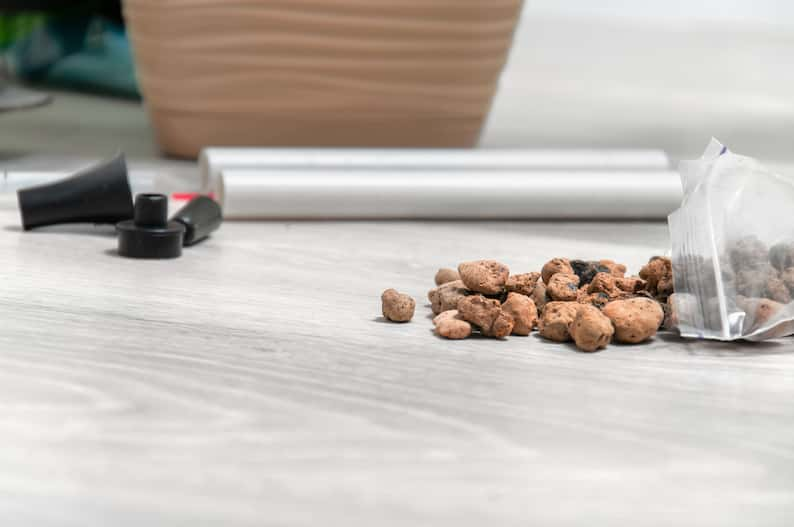Some people swear by putting rocks in the bottom of their plant pots. And others are committed to putting rocks on top of potted plants, whether it’s for the health of the plant or purely for aesthetics.
But why put rocks in potted plants? And are stones even good for potted plants or are there better ways to achieve the goals that people have in doing this?
There are actually some advantages to this! But, as you’ll see, there’s also one massive myth that a lot of so-called gardening experts mention about needing rocks in potted plants, that especially relates to using rocks for plant drainage.
Let’s check out the benefits – while also engaging in some plant-related mythbusting.

Table of Contents
Why put rocks in potted plants?
Rocks can be put in potted plants for aesthetic purposes, to protect the plant from pests and other animals, to improve water retention by limiting evaporation and to protect the soil from being lifted out by wind or rain. A single rock in the bottom of a plant’s pot can also help with drainage.
Putting rocks on top of potted plants can actually be a great idea for these reasons and I’ll run through below why using just one stone can be a good solution for any drainage issues.
However, you sometimes come across people who believe that you need rocks for potted plants down the bottom of each planter. As I’ll show you, the reasoning behind this is less sound.
Is putting rocks on top of potted plants good?
Putting rocks on top of potted plants can be a good strategy, especially to help to prevent evaporation and avoid soil washing away when you water your plants. It also helps to keep the soil from getting on any low leaves.
This means that putting rocks on top of potted plants is great both for the plants themselves and the room where you keep your houseplant, especially if it’s near a door or a window that’s occasionally open and lets the wind in. No one’s really a fan of coming home and finding soil scattered all over the floor, right?

There’s also the added benefit that adding small pebbles for indoor plants can look really beautiful, giving your plant a tidy, “finished” look.
You can use more natural-colored decorative gravel for plant pots, although I’m personally a fan of the clean elegance of these white stones.
Can you put rocks on top of indoor plants?
You can definitely put rocks on top of indoor plants, especially if you want to hide the dirt or discourage pets from digging around in there. Colored stones in particular can look great in indoor plants and really help to lift your entire room.
While the weather-related issues probably won’t be quite as important for your houseplant compared to if it lived outdoors, no one’s judging you for thinking of your decor. As mentioned above, those sleek white rocks will look beautiful or your more natural look at home can be given a boost by the similarly natural-looking stones.
Of course, there are always these rainbow-colored stones for your plant which could fit your personality to a tee!
Should I put rocks on top of my plant?
Putting rocks on top of potted plants is arguably better for outdoor plants compared to indoor ones. Outdoor plants have to deal with wind and rain blowing soil away, as well as evaporation. While these can also be issues with houseplants, they can often be more easily managed indoors.
That said, there’s no real harm in doing so. It can even be a great decorative addition, which may be perfect for helping your houseplant to elevate your overall decor!

Do rocks prevent fungus gnats?
One great advantage of putting rocks in potted plants is that they prevent fungus gnats from laying eggs in your plant’s soil, while trapping any that are already in there. Using stones for this purpose is a very effective, entirely organic way to deter pests.
Putting pebbles on top of soil can be particularly effective for houseplants if you aren’t keen on the idea of spraying pesticides in your home. Plus, you’ve still got the added advantage of the rocks looking good while serving a practical purpose too!
You may also be interested in: 15 Best Houseplant Books for Beginners
Can you put rocks around plants?
Putting rocks around plants in a tray is a great way to increase humidity for indoor plants that need more moisture. Using a pebble tray also provides space for drainage, given it will be located directly below your pot.
This is an especially great tip for tropical plants which can often find the indoor environment of most homes as being more dry than they prefer. While you can mist your indoor plants as one way to help with this, using a pebble tray is also another easy solution.
How to make a pebble tray
Simply take your plant saucer (if you don’t have any, this pack of plant saucers is an easy buy) and add a single layer of pebbles, which can include either small decorative stones or simply some small rocks you find outside.
Add enough water so that it comes about halfway up the stones. Place the pot on top of the rocks – and that’s basically it! Make sure you check on the water from time to time so you can refill it when the water level drops.
Do you need rocks for potted plants?
You do not need to put rocks in the bottom of plant pots as they do not help with drainage or air circulation, despite this being a common theory. In fact, they can actually encourage root rot. One rock to cover the drainage hole is enough.
That is, when people ask why put rocks in potted plants, they usually have some idea that they can use rocks for plant drainage. The same thing happens with people who have been told about adding gravel to soil for drainage, putting wood chips in the bottom of a planter or adding charcoal in the bottom of pots.
Unfortunately, while people who do this definitely have their plants’ needs in mind, this actually has the opposite effect, by causing their plant to hold on to more moisture and even cause root rot.
Do rocks at the bottom of a planter help drainage?
Putting rocks in potted plants can actually make drainage worse. This is because you’re simply lifting the soil inside the pot while it holds the same amount of water, just now in a smaller space. This won’t help the water drain faster and can lead to the plant being more water logged.
Think of it like this: if you soak a sponge, it will hold on to its water. Even if you balance it on some gravel for house plants, these won’t help the sponge dry out any faster.
If you then put the sponge on its side so it’s now taller but still placed on the rocks below it, the now-bottom of the sponge will become wetter as gravity takes effect. However, the water still won’t drain out any faster unless you squeeze the sponge. It also doesn’t mean that air is circulating more easily inside the sponge.

Now, we’re not talking about squeezing your plants here (although feel free!). Instead, your plant’s soil is the sponge. And as this shows, it’s the soil itself that determines how fast the water eventually drains, not what’s put underneath it – including any rocks for plant drainage that you might add.
By putting rocks in the bottom of plant pots, you’re effectively making the soil area of the pot smaller, meaning the “sponge” holding the water in is also now smaller. This means that all that water being held is pooling closer to – or even directly around – your plant’s roots. And this means that adding rocks for plant drainage can easily lead to root rot.
What do you put in the bottom of a planter for drainage?
You should ensure that your planter already has a drainage hole and you can then add one stone over the hole to help with drainage. By adding this, you’ll stop all the potting mix from falling through while still allowing water to drain slowly out.
It’s also important to simply make sure you always use well-draining soil.
If you’d rather improve the soil you already have and are looking for how to add drainage to soil, some options include:
- Perlite – This is a small, light, puffy rock that takes up space. When mixed through soil, it helps prevent clumping and can also hold on to water, which means less held moisture in the soil itself.
- Vermiculite – Vermiculite is similar to perlite in that not only is it absorbent, but it works really well for breaking up soil and avoiding too much water from being held in it. It’s often a great idea to add both this and perlite to soil to really help your houseplants thrive.
- Sand – An easy solution that you may have already, sand works well by getting in between clods of soil to break it up, improve drainage and increase aeration.
What can I use instead of rocks in a planter?
To improve drainage, try lining the bottom of a planter with paper towel, a coffee filter or even a newspaper. These are all items that are sufficiently porous for allowing the water to drain out while still ensuring that potting mix won’t fall out of the drainage hole.
An even better part of these solutions is that you probably have at least one of these lying around at home, so they’re free! Of course, there are some other options that are more tailor-made to this purpose, as I’ll outline below.
But there’s no harm in using a homemade solution either, especially as it will be at the bottom of a planter so no one will see it.
You may also be interested in: 21 Best Indoor Self-Watering Planters (That Look Amazing)
Should I line my planter box with plastic for drainage?
Lining your planter box with plastic is a good idea for houseplants as it helps make sure that the soil does not escape through the bottom. However, make sure you add holes to the plastic to allow water to drain out.
You can actually buy mesh mats for the bottom of your pot that do exactly this. However, if you already have a plastic sheet at home, the DIY option is also fine.

What can I use to fill the bottom of a large planter?
If you have a large planter, it can take a lot of potting soil to fill it completely. You may also be looking for how to weigh down plastic planters if you feel that yours are too top-heavy and could tip over if they’re just filled with soil.
This means that, when looking for what to fill a large planter with, you can use any of the following:
- Gravel for house plants – As covered above, putting rocks in the bottom of plant pots won’t help with drainage or air circulation. But they can be great for filling space and are especially good if you’re looking to weigh down plastic planters.
- Wood chips – These are a really good natural solution, although they will break down eventually. The smaller they are, the faster they’ll decompose.
- Plastic bottles – These won’t help much with weight, but if you don’t need that aspect, it’s a good way to recycle your plastic bottles rather than throwing them out.
- Packing peanuts – If you’ve moved recently and don’t know what to do with all those leftover packing peanuts, put them in the bottom of your planter! Styrofoam isn’t great for the environment though so if you’re considering buying new packing peanuts to fill the bottom of a large planter, it’s best to go for one of the more natural options above.
Final thoughts on putting rocks in the bottom of plant pots
Putting rocks on top of potted plants has a number of benefits, both for outdoor and indoor plants. If you’re looking for why to put rocks in potted plants and it’s for one of the reasons mentioned above, then you’re on the right track.
However, it’s not entirely clear where the thought of using rocks for plant drainage came from. Perhaps it was a misunderstanding of the purpose of the rock you can put over each drainage hole. Or perhaps it was simply something passed down from one plant owner to the next.
Either way, you can rest assured that you don’t need to do this and that there are far more effective ways to promote drainage and air circulation in your houseplants.
This is especially the case with the vast majority of pots you can buy these days, which almost always come with drainage holes built into them. With the exception of the rock (or similar item) we’d recommend putting over each of these, stick to keeping the stones either on top or underneath each indoor plant, depending on what you’re trying to achieve.
